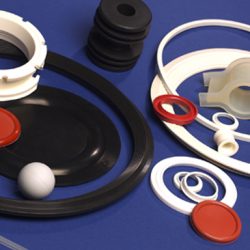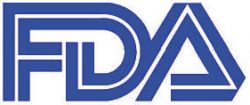FDA Seals
FDA Seals – Full Documentation Provided. International Delivery.
M Barnwell Services is one of the UK’s leading supplier of FDA Seals for the Processing, Packaging and Food / Beverage / Pharma Industries.
They are also compliant with European Regulations EC1935/2004 & EC2023/2006. Other certifications and compliances include BfR XXI/1 Category 4, 3-A Standard 18-03 Class I, and BAM (reactivity with oxygen).
O-Rings, hygienic gaskets and custom-designed components can be manufactured from over 40 FDA-compliant rubber material grades. These include:
- Class A-D (dry foods): EPDM, NBR, Silicone, FKM
- Class A-E (aqueous foods): EPDM
- Class A-F (fatty foods): EPDM, HNBR, Silicone, FKM, FFKM, Metal Detectable Elastomers
Our popular FDA Seals and services include:
- RJT O Rings BS4825 PART 5: Materials include NBR, EPDM, Viton®, and PTFE
- Encapsulated O Rings: FEP/PFA Jacket – FDA, USP Class VI
- O Rings DIN11864-2: For Pipe Couplings
- Hygienic Clamp Seals: (DIN32676, ISO02852, BS4825, ISO1127) Tri-Clover / Tri-Clamp Seals / Hyclamp / Polyclamp / Clamp Seal Selection Boxes & Kits
- IDF Gaskets: (International Dairy Federation) ISO2853 / DRJ Rings
- Oxygen Cleaning
- Camlock Gaskets: (FEP/PFA) Viton® or Silicone Core
- SMS 1149 Rect. Section Rings (Swedish Standard)
- DIN11851 D Seal (DIN Union)
- Diaphragms: Rolling and Flat. Garlock’s speciality range of Garlock‘s ONE-UP® Pump Diaphragms range
- Clean Room Service: Class 10,000
- X-Ray and Metal Detectable Seals
- Butterfly Valve Seals: the Operating Shaft Seal, the Pipe Seal, and the Flange Seal / FDA, EC Regs, 3-A Sanitary
- PTFE Shaft Seals
- Specialist Aseptic Food Grade Gaskets – Garlock’s Gylon Bio Line
It is crucial to purchase FDA Seals from a reputable company, who fully understand the regulations as well as your requirements. M Barnwell Services’ industry experience and extensive range mean we can source a range of quality FDA compliant compounds that will be suitable to your specific requirements. We can also provide bespoke FDA Seals and Custom Parts, specially engineered to suit your specific application.
Contact us for more information or to request a quote.
Sealing Solutions For
- Mixers – Homogenization, agitator, separator, heat exchangers, heat recovery
- Cooking Vessels – Line ovens, pressure cookers, boilers
- Extrusions – Rolling, Layering, depositing, conveying, cutting, shaping, moulding, lifting, coating
- Heat / Cold treatment – Pasteurization, Autoclave (removal bacteria) heat exchanger / heat recovery. Cooling, refrigeration, freezing, tempering
- Packaging – Boxing, sachet, canning, bottling, sealing, lids, X-Ray/ metal detection
- Process – Goods in, raw materials, refining, grinding, cutting, milling, sieving (Flour/sugar/fats silo storage, IBCs, distribution, pumps pipework in-line seals RJTs, SMS, pumps, valves & control)
- Brands – Lutetia, Unifiller, Apple, Mettler Toledo, Retort and many more
What are FDA Seals and what do they do?
Food and Drug Administration (FDA) is an agency within the U.S. Department of Health and Human Services responsible for overseeing the manufacturing and distribution of consumer products such as food, pharmaceuticals, electronic products that emit radiation, and medical devices together with the development of biological products such as cosmetics, products that treat allergies, and vaccines. All FDA produced materials are handled and packaged in a certified cleanroom environment and subjected to strict testing to meet the requirements of the most demanding food and beverage processing operations. FDA manages a list of materials and chemicals that are approved for contact with foods. They make sure those products are safe to use, effective and accurately labelled. Materials that meet these requirements are then declared as FDA Compliant.
FDA compliant rubber materials usually are:
- Used for food, drink, dairy, meat or any food-compliant chemicals
- Dependable service at the broad scope of temperature
- Inodorous, tasteless and present essential resistance to bacteria escalation
- Non-allergenic, non-toxic and non-marking
FDA CFR 21.177.2600 (paragraphs A – D) represent the applicable regulations for ‘Rubber articles intended for repeated use’. These paragraphs list the components and numerical restraints that may be used in rubber compounds for formed products intended for repeated use in all stages of food production, preparation, and freightage.
FDA CFR 21.177.2600 (paragraphs E & F) specifies restraints on extractable products if the FDA rubber seal is intended to be used in contact with water or greasy foods. The regulation details extraction test limits in water and n-hexane. For the FDA rubber material to be compliant with these regulations, this claim must be backed with relevant documentation such as manufacturer’s FDA Compliance Certificate.
FDA does not ‘approve’ products to CFR 21.177.2600. The manufacturer has the responsibility to prove compliance by publishing an FDA Certificate. A component may be produced using an FDA rubber material that is adequate for food contact; this does not imply that the part is technically suitable for its planned application.
Above compounds must consist entirely of the elements recorded in the FDA’s White List situated in the Code of Federal regulations (title 21). O-ring producers must exploit food-grade materials solely from the whitelist of FDA’s endorsed ingredients.
E & OE.


